Part 1 – Kathmandu to Manang
While the Annapurna Circuit Trek Guide helps you plan an epic adventure, this post will explain what it’s like to trek the Annapurna Circuit. This blog post covers why trekking for 2 weeks changed my perspective on travel and what I gained from the experience. To begin with, the first part will include arriving in Kathmandu, travelling to the Trek start and then the first 4 days of trekking.
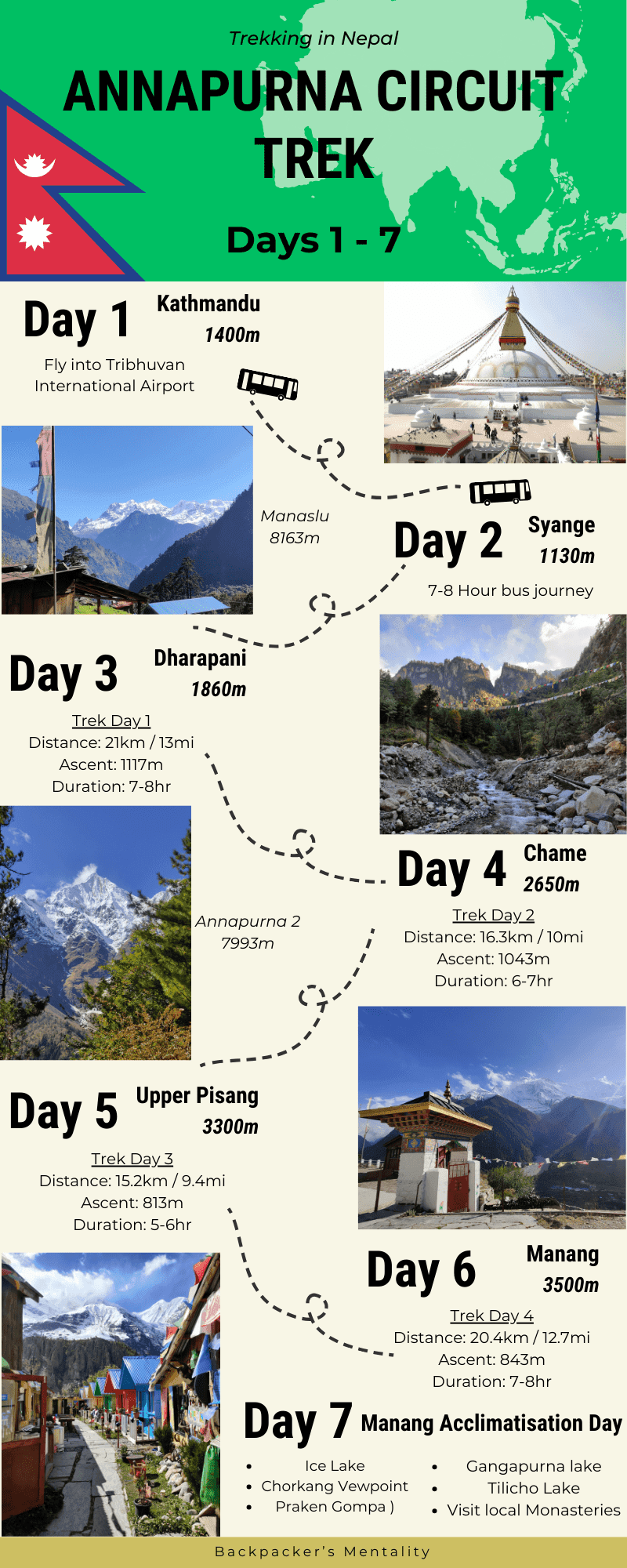
Why I Loved the Annapurna Trek
The Annapurna Circuit was my first experience of trekking and high altitude. I travelled outside of Europe for the first time with my backpack full and excited to discover the mysterious Nepalese Himalayas. After years of alpine hiking, I was keen on a new challenge and tackling the world’s highest trekking pass at 5416m sounded perfect. One reason I loved Annapurna was to see multiple 8000m mountains (Annapurna, Dhaulagiri & Manaslu) which tower above the valleys & other mountains. These peaks have a reputation for being extremely dangerous and it’s easy to see why given the sheerness. As a result, trekkers are mesmerised by the breathtaking mountainous landscapes with plentiful photo opportunities. The trek takes you through multiple climates and ecosystems from jungle to alpine forest then up to arid villages before the snow-covered Thorong La Pass. And in combination with Buddhist culture, it gives this trek an added dimension
The other reasons for my love of this trek were the teahouses and fellow Backpackers. Each teahouse had a different but equally welcoming atmosphere with a log fire to stay toasty. It was a place to meet other travellers over chai tea, playing cards or eating unlimited Dal Bhat! It’s a popular trek but I found the trails were fairly quiet and you weren’t always staying with the same groups. As a solo trekker, it was easy with my guide to chat with other tour groups and make friends. Before the trek, I bought small Moleskine field journals to document and sketch my travels. These turned into a great chance to reflect on the experience and turned into a souvenir for afterwards. Since then, I have grown a collection of travel journals from every trip abroad. The Annapurna journals were where it started and sparked the idea for a blog!
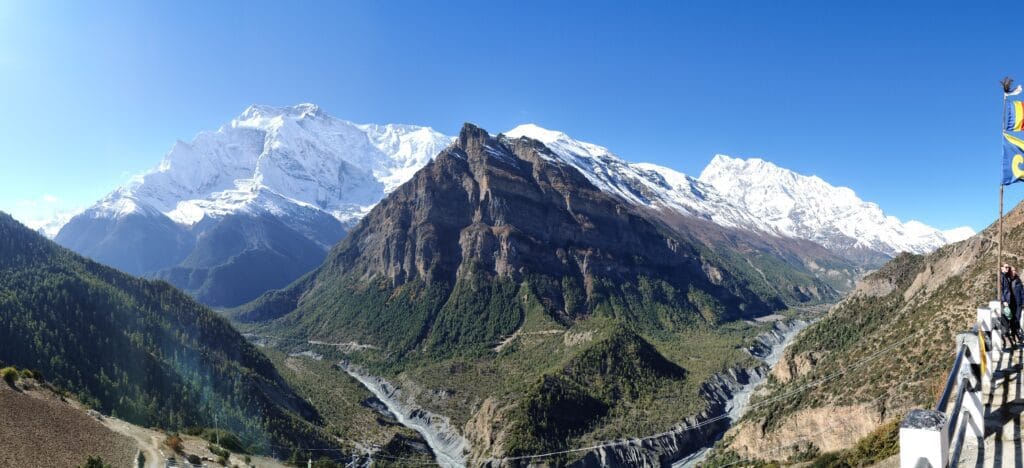
Annapurna Circuit: Day 0 & 1
It all started with an evening flight from London Heathrow (Day 0) through the night to Doha, Qatar for a connecting flight.I would be lying if I said I wasn’t anxious at Heathrow when I was dropped off about to begin the journey. I arrived in Kathmandu at Tribhuvan Int Airport the next day in the evening after 14 hours of flying. Upon arrival, it was a whole process to gain entry including COVID checks, VISA fees, immigration docs, bag retrieval and exchanging cash. Finally, I met my Guide, Dawa from Sherpa Expedition & Trekking where I felt slightly easier. My first impression of Kathmandu was chaos! The roads were an uncontrolled mess of taxis & buses slowly winding through the city with scooters squeezing into non-existent gaps. Day 2 was a long travel day so there was no time to explore Kathmandu unfortunately after arriving at Hotel Thamel Park late.
Annapurna Circuit: Day 2 – Kathmandu to Syange
Today was a 7-8 hour bus journey from the Capital to Besisahar to start then a Jeep ride to Syange. I was not fully prepared for the difference in Eastern bus travel compared to the West and was a cultural shock. To start with, a dodgy taxi ride to the bus station where you’re harassed to get onto various buses. Without Dawa, I would have been lost but he managed to secure back-row seats! It’s odd seeing backpacks and luggage stored on the roof and as I found along with food & goods deliveries the driver does as a side hustle. Kathmandu had a layer of pollution overhead so I was pleased to escape even if the traffic was walking pace.
It was a long ride full of pauses and traffic with occasional breaks. During a lunch stop, I had my first taste of Dal Bhat which was an explosion of flavour and I was baffled by the second and third servings! One lesson was to not leave anything easy to steal off your backpack as I lost a Petzl Carabiner. Despite this annoyance, my spirits were high while we sipped tea before a bumpy Jeep journey towards Syange. Impressive waterfalls were plotted along the track and the first views of the Himalaya peaks could be seen poking through the white clouds. The first teahouse was colourful and had excellent amenities with an en-suite bathroom, double bed and WiFi! I started to chat with other Trekkers from various nationalities as we ate dinner together in the communal area. I was eager to start the trek after over 2 days of travel!
Annapurna Circuit: Day 3 – Syange to Dharapani
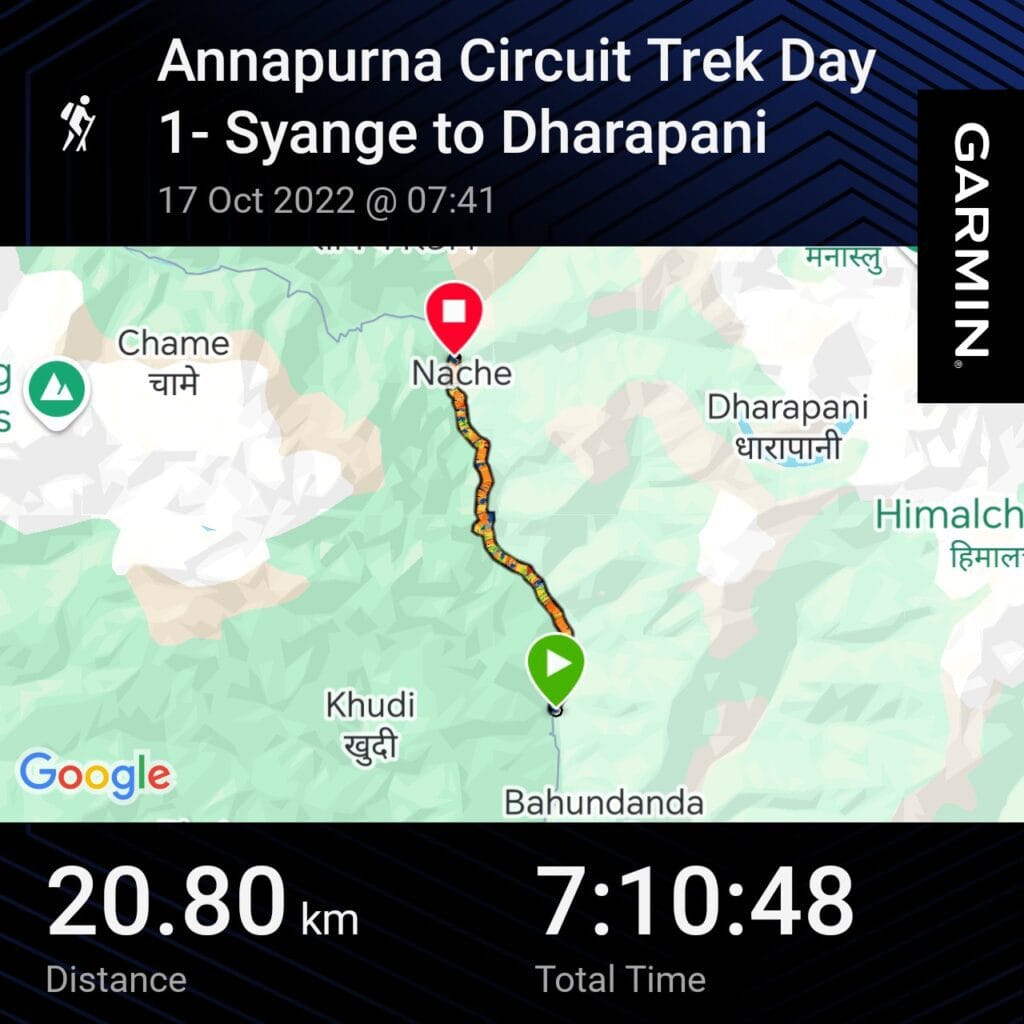
Distance –20.8 km
Ascent –1117 m
Descent – 331m
Moving Time – 4h12
Max Altitude – 2061m
Avg Pace – 20:42/km
Starting Point – Syange (1100m)
End Point – Dharapnai (1860m)
Weather Conditions –Sunny, clear skies and 20°C
Day 1 was a mighty 20km and 1100m climbing hike- a nice introduction to Nepal. Firstly, we trekked along the road through the jungle, passing small settlements and huge waterfalls. The Osprey Atmos 50 AG was a great investment to carry all the trekking gear weighing in at 18kg. At lunch, I noticed the relaxed pace of life in the mountains and villages plus how catering the locals were. In the distance, Pisang Peak and Kang Guru drew the eye’s gaze. We arrived at Dharapani by 3pm which was another reason to not rush. At the teahouses, there’s not much to do unless you’re in a town like Chame, Manang or Pisang. Accommodation was a simple twin room and a very cold communal room but good Dal Bhat (all that matters). Spent the evening exchanging stories with other trekkers and having a good laugh.
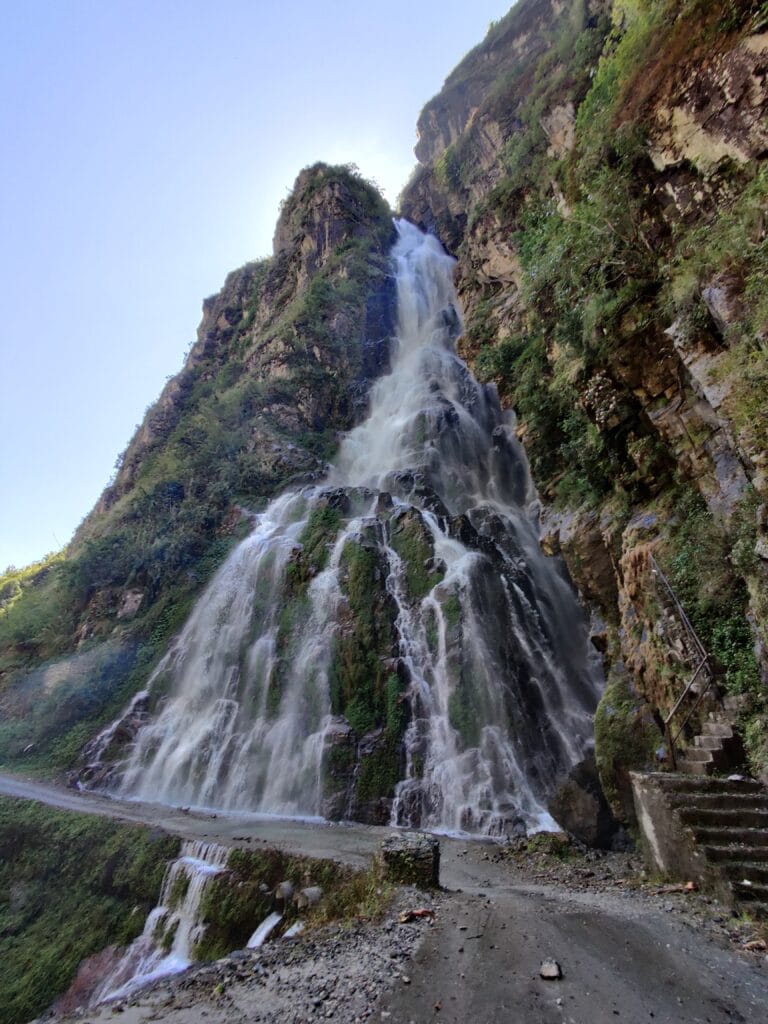
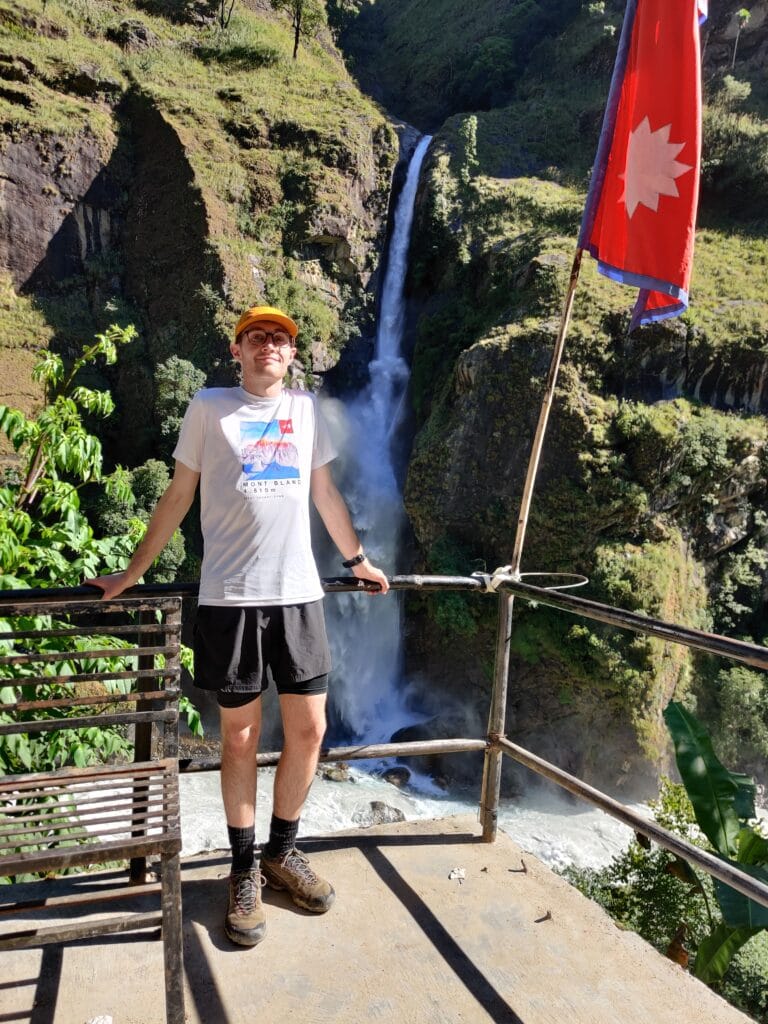
Annapurna Circuit: Day 4 – Dharapani to Chame
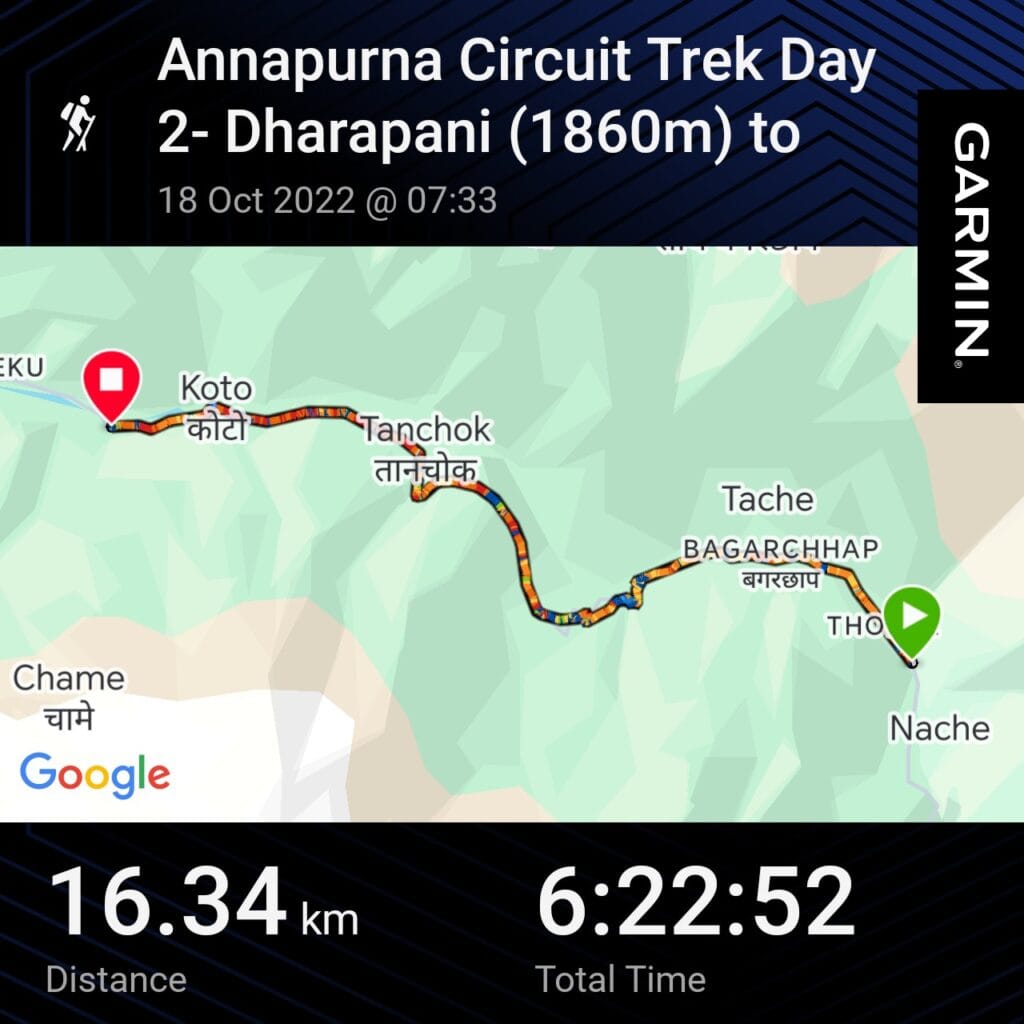
Distance – 16.34km
Ascent – 1043m
Descent – 247m
Moving Time – 3h30
Max Altitude – 2650m
Avg Pace – 23:26/km
Starting Point – Dharapani (1860m)
End Point – Chame (2650m)
Weather Conditions –Sunny, clear skies, 18°C
Most days I woke around 6am to meditate, stretch and pack up before breakfast at 7am. Once the 2L water had been purified with Chlorine Dioxide and I paid for the drinks bill, we were off towards Chame. A quick ANCAP checkpoint was close by and I got the first views of Manaslu, Annapurna 2 and Lamjung! It felt much busier with groups, bikes and jeeps en route Day 4. The villages we walked through had colourful prayer flags hung everywhere with mani wheels along the road. We climbed higher along narrow passages to Timang for lunch with a fabulous panoramic. I sat on a rooftop enjoying chai tea and Dal Bhat with crystal clear views of Manaslu, I felt very content with life.
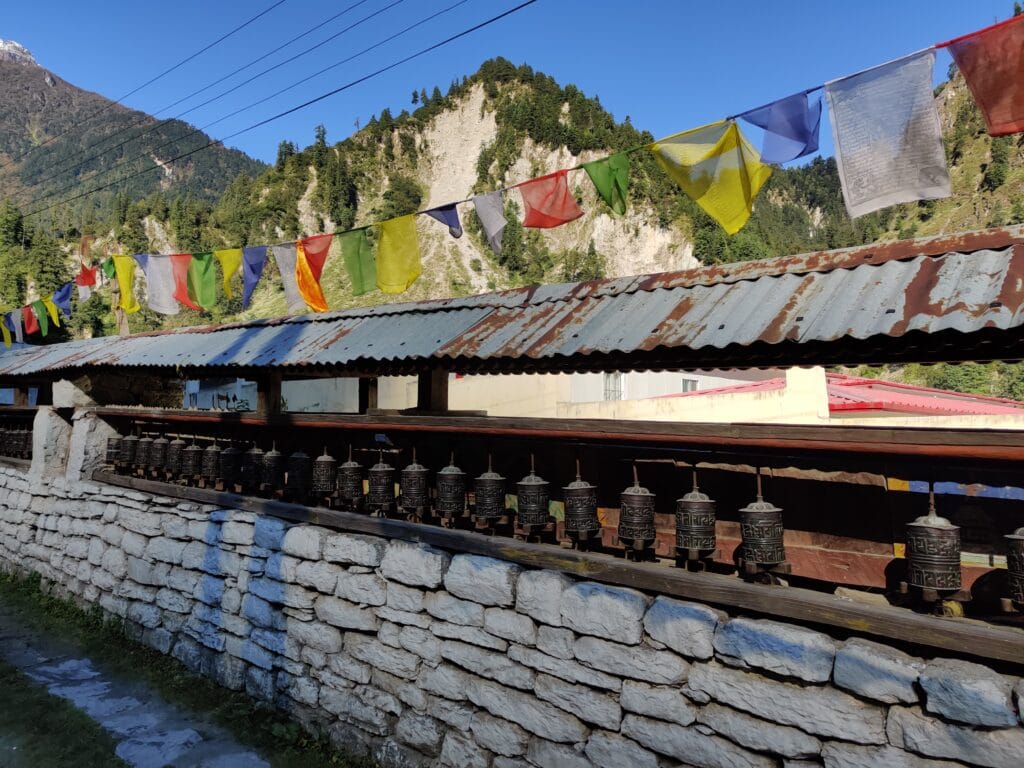
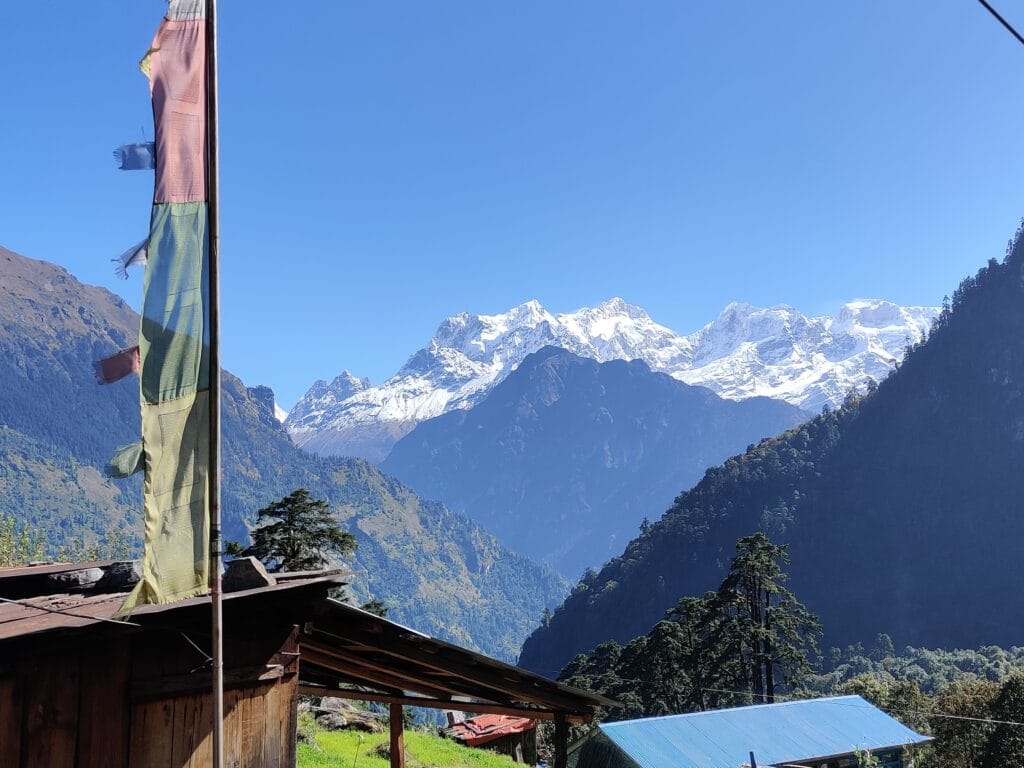
The trail continued to climb past buckwheat fields with Manaslu in the distance. Before long, we arrived at Koto for another checkpoint and saw the valley for the Nur Phu Trek and Tibet. A fast 25mins hike into Chame before resting up for the evening. My room was a brightly painted chalet with incredible views of Manaslu. Chame is a small village with bakeries, shops and plenty of tea houses! It is great to pick up any forgotten items such as ice crampons in my case. This was wise advice from Dawa for Thorong La Pass and cheaper than Manang in a few days. Tilicho Guesthouse was our accommodation for the night which had a good atmosphere where trekkers gathered around the large fire for warmth. The huts were freezing cold at night so bring a 4-season sleeping bag!
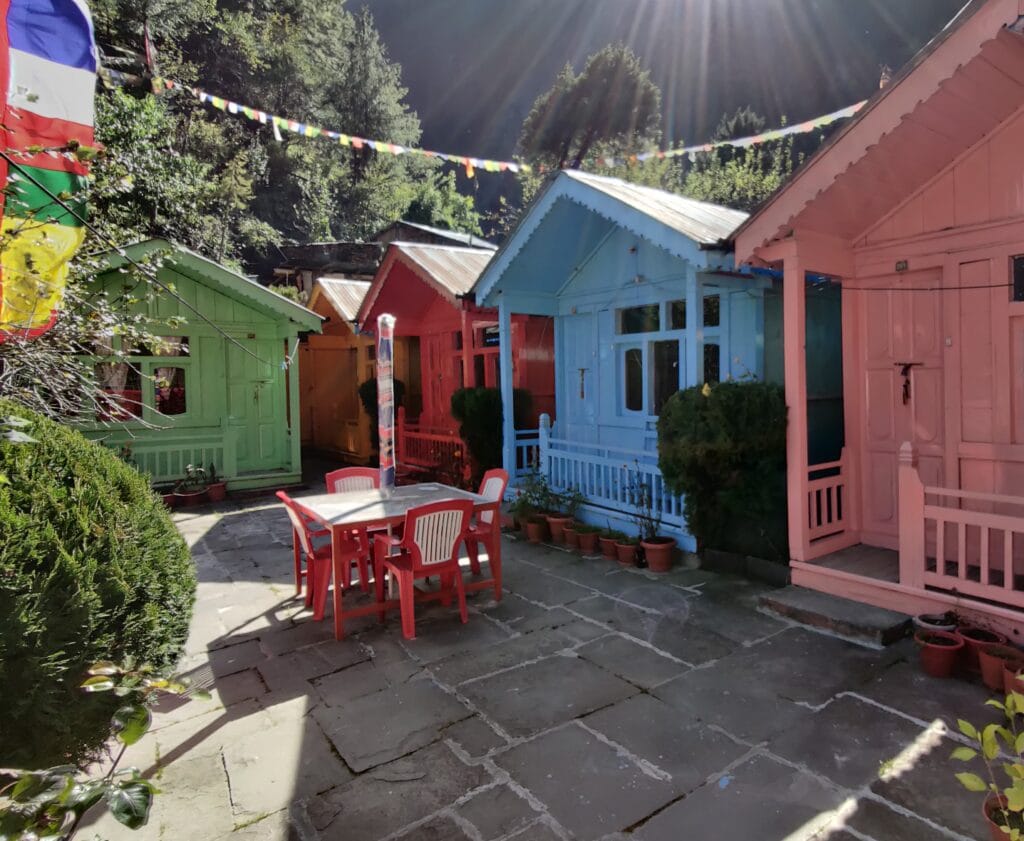
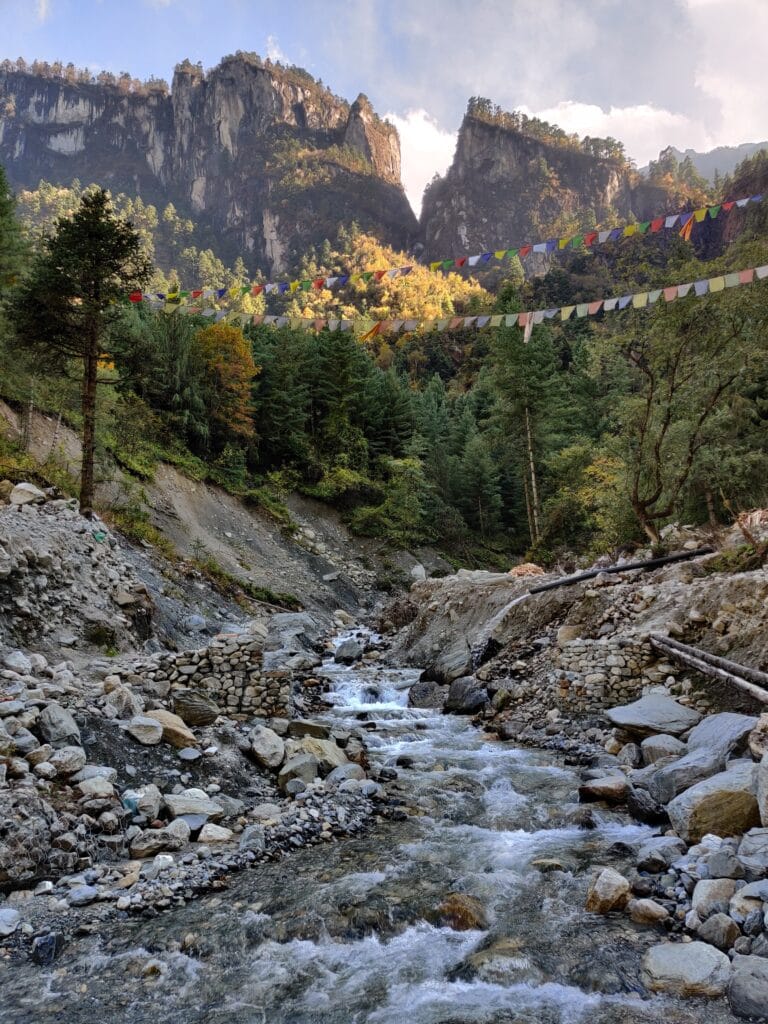
Annapurna Circuit: Day 5 – Chame to Upper Pisang
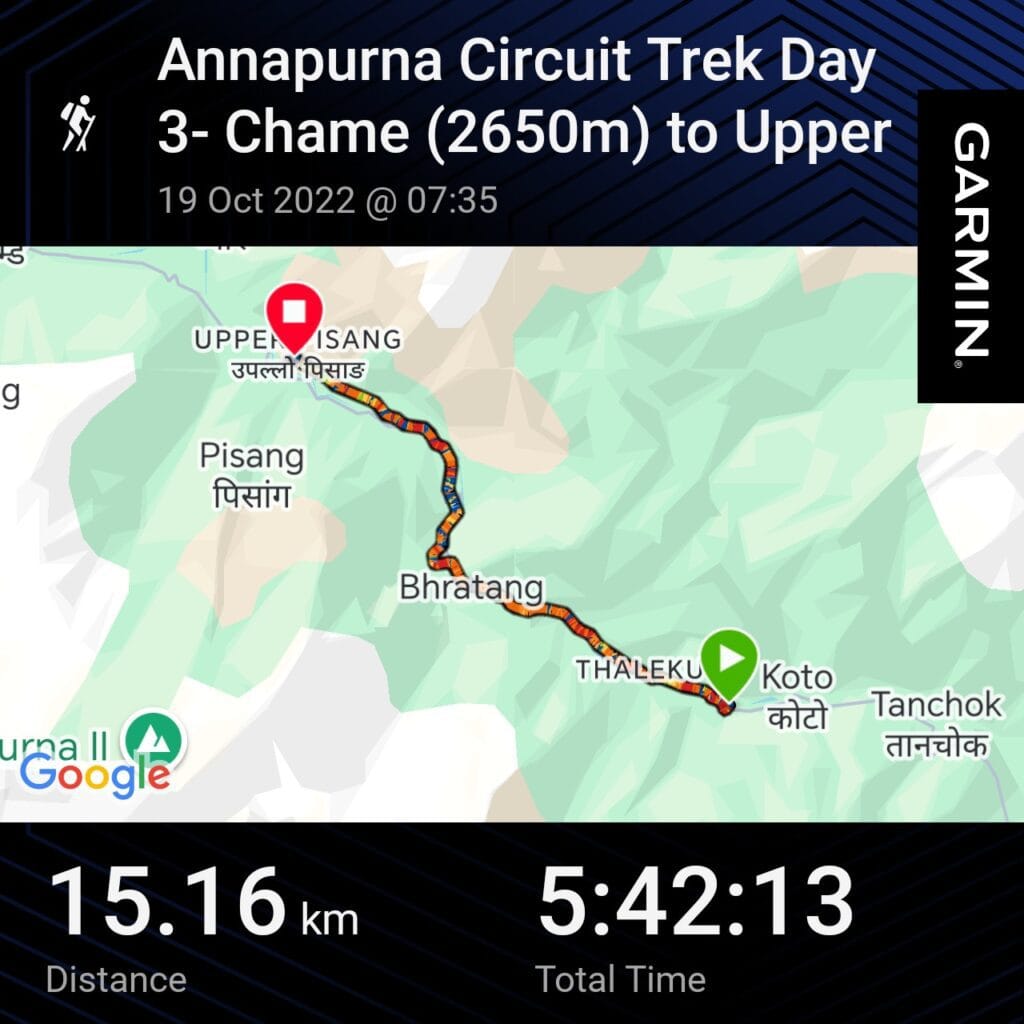
Distance – 15.16km
Ascent – 813m
Descent – 216m
Moving Time – 3h06
Max Altitude – 2648m
Avg Pace – 22:35/km
Starting Point – Chame (2650m)
End Point – Upper Pisang (3300m)
Weather Conditions – Sun and clouds, some wind, 15°C
For breakfasts, Tsampa porridge and pancakes were common options and great trekking fuel for the morning. By Trekking Day 3, the backpacks felt marginally lighter and the body had adapted to the load even with the climbing & altitude. From Chame, the trek continues in thick pine forests similar to those of the Alps or North America. You’ll pass Brahtang with its impressive apple orchard that’s worth a stop for tea and apple doughnuts – to die for! The trail felt busier from Chame towards Pisang, especially with mountain biking tours. The views of Annapurna 2 are some of my favourites from the Circuit! It was fun crossing the Tibetan-style bridges before reaching Heaven’s Gate (Paungda Danda), a gigantic curved smooth wall on the north side. It looms over the Marshyangdi River along with the Annapurna range opposite.
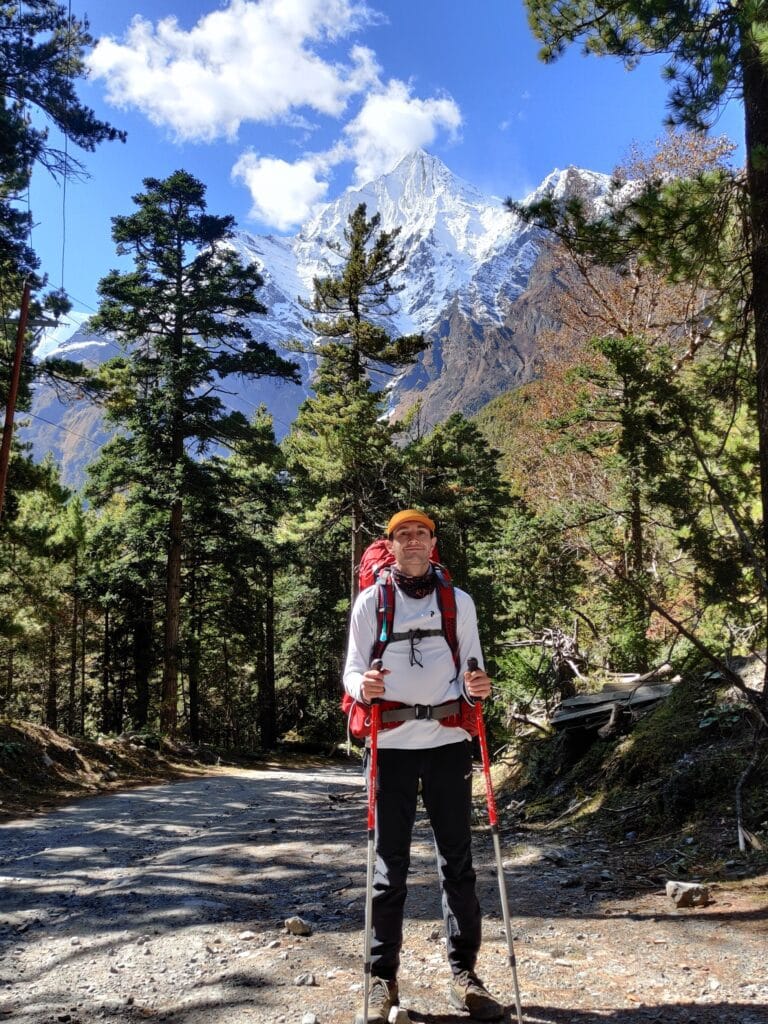
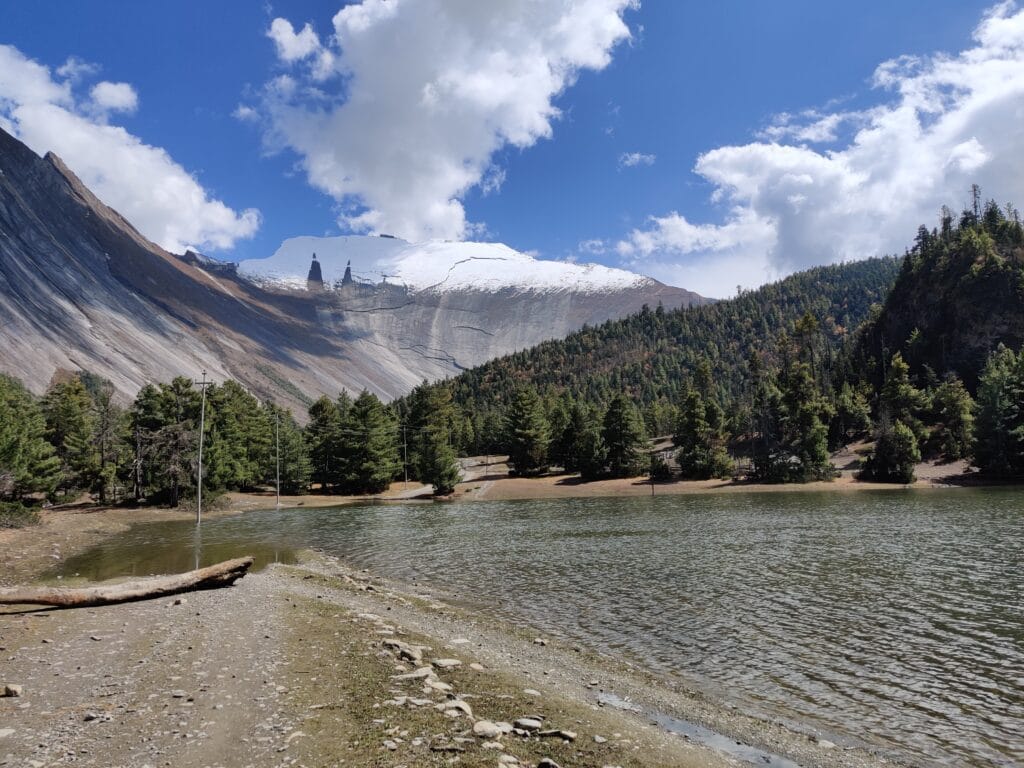
Another day and another Dal Bhat on a roof for lunch! As I hiked along the Circuit, I began to chat more with people and create a trekking bond as we shared that journey. The scenery changed again to be more arid and dusty towards Pisang with a large lake that engulfed football pitches. We checked into Hotel Mandala and then explored the Gompa (Monastery) which was an definite highlight of the trip! The Stupa, Gompa and views across the valley to Annapurna 2 were spectacular. I fondly remember the evening of excellent Dal Bhat, drinking tea and sharing stories with a group of Dutch girls while playing cards. At night, we stood on the roof and stargazed before warming up by the log fire.
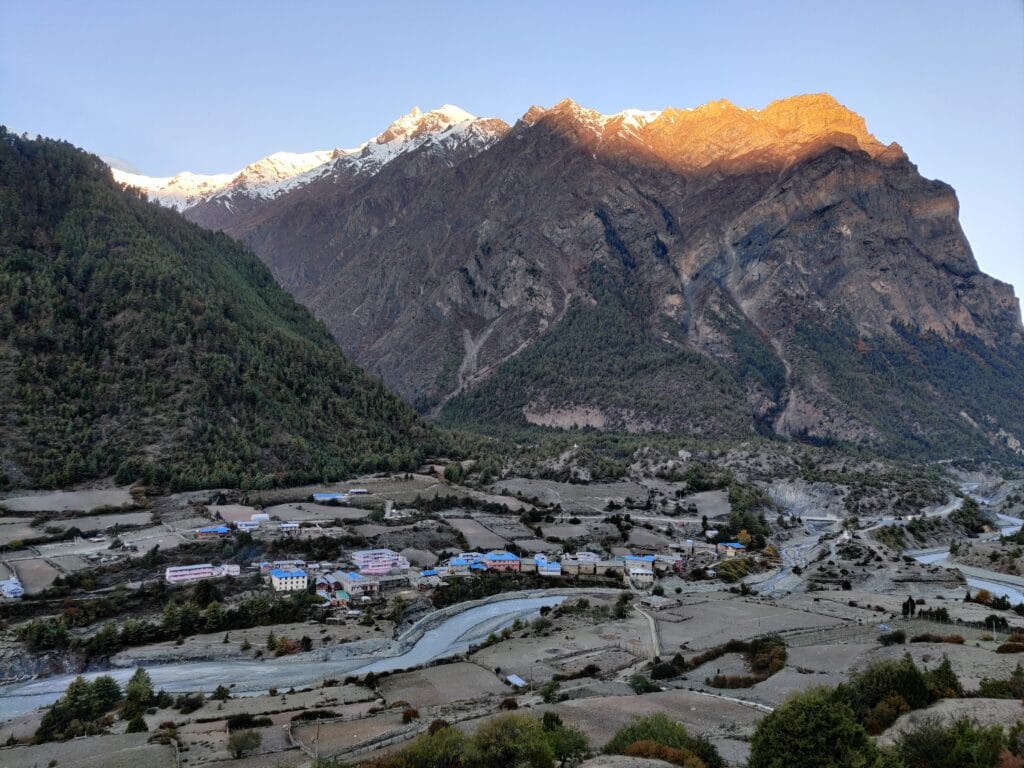
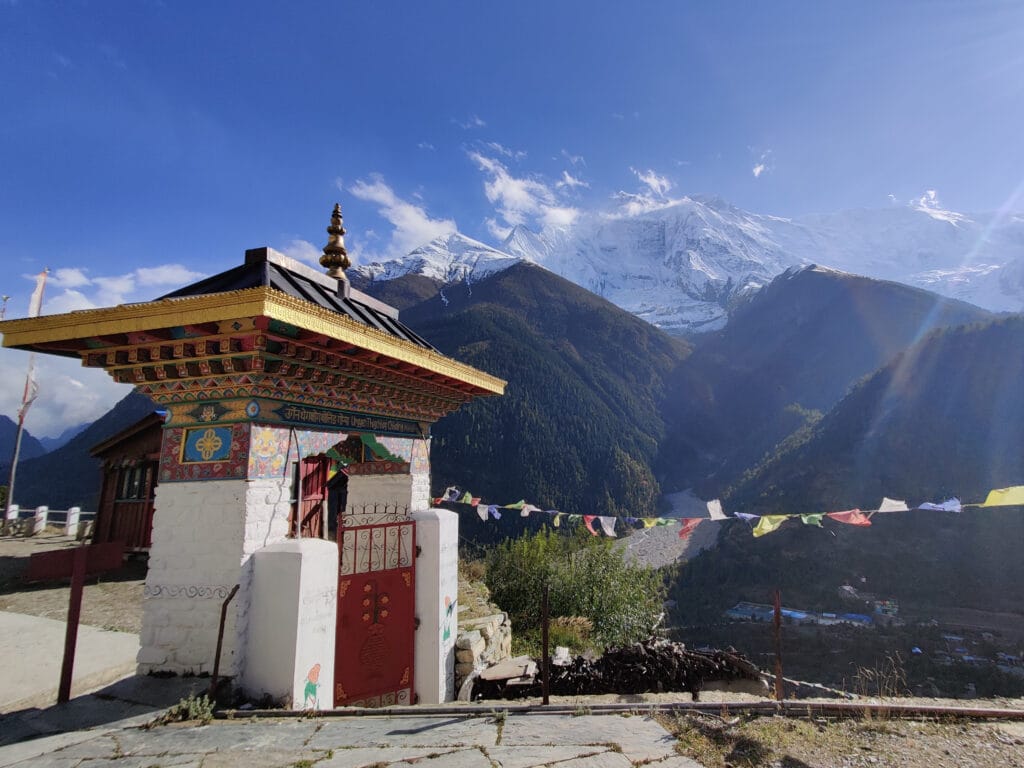
Annapurna Circuit: Day 6- Upper Pisang to Manang
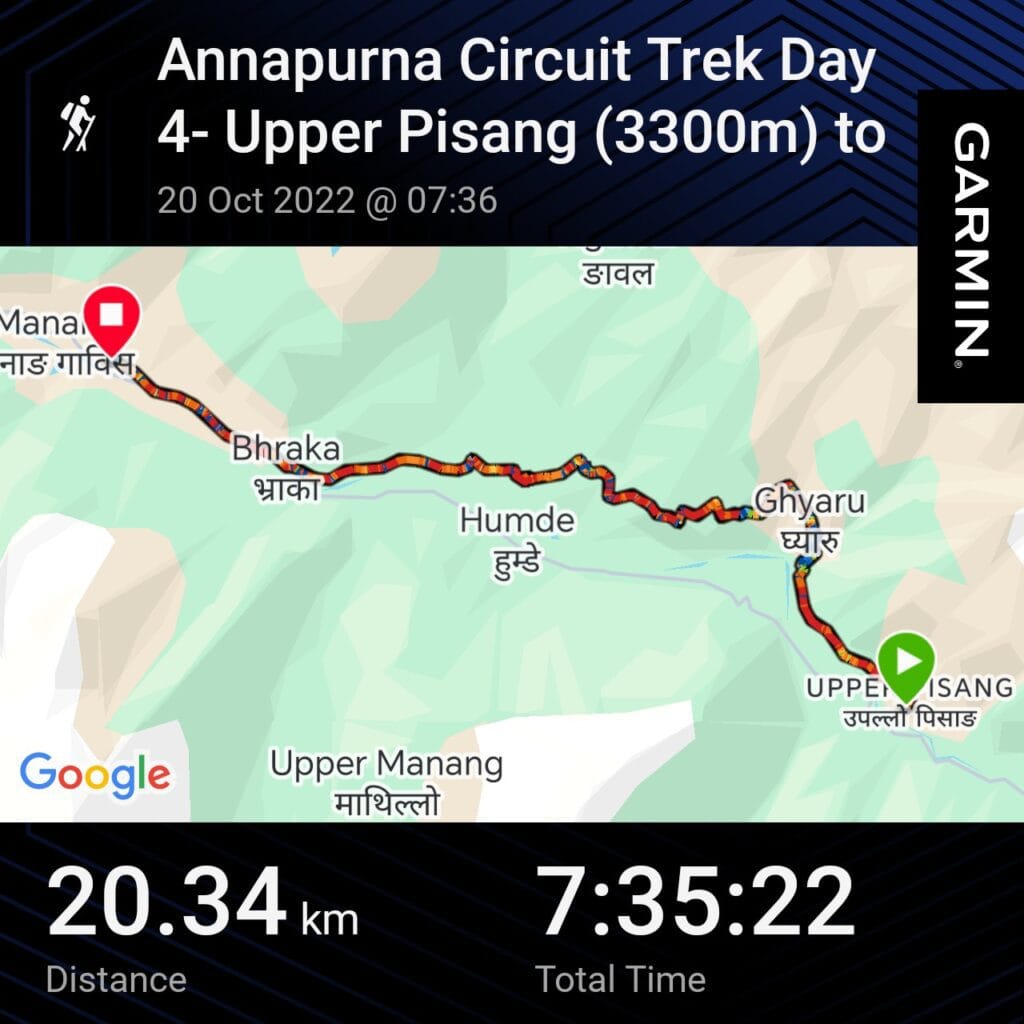
Distance – 20.34km
Ascent – 843m
Descent – 593m
Moving Time – 4h05
Max Altitude – 3760m
Avg Pace – 22:24/km
Starting Point – Upper Pisang (3300m)
End Point – Manang (3500m)
Weather Conditions –Sunny day, clear skies and 20°C
Trekking Day 4 had my absolute favourite viewpoint on the Annapurna Circuit! After Upper Pisang, the gruelling climb up 350m to Ghyru is rewarded with a stunning panoramic. It was tough going up the steep path and the thin air became apparent. I enjoyed a quick apple pastry before taking pics at the viewpoint. The trail continues through wooden and stone buildings with a medieval look as we climb higher and higher. We stopped at a Stupa with another great panoramic view of the valley already climbed and what was to come.
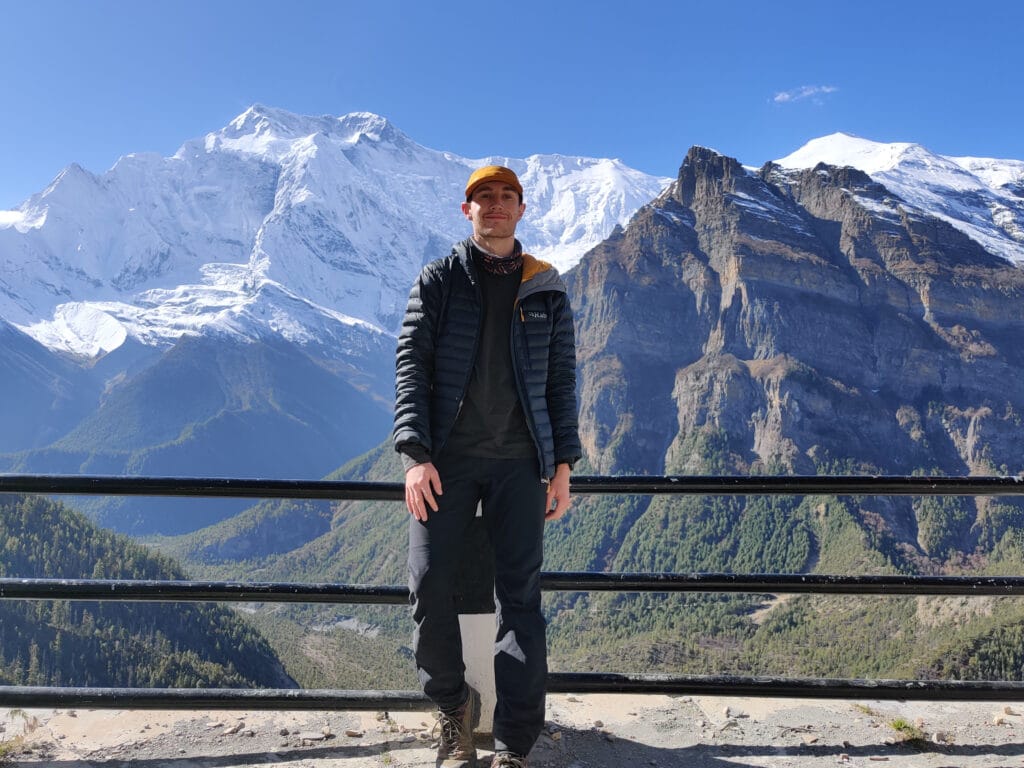
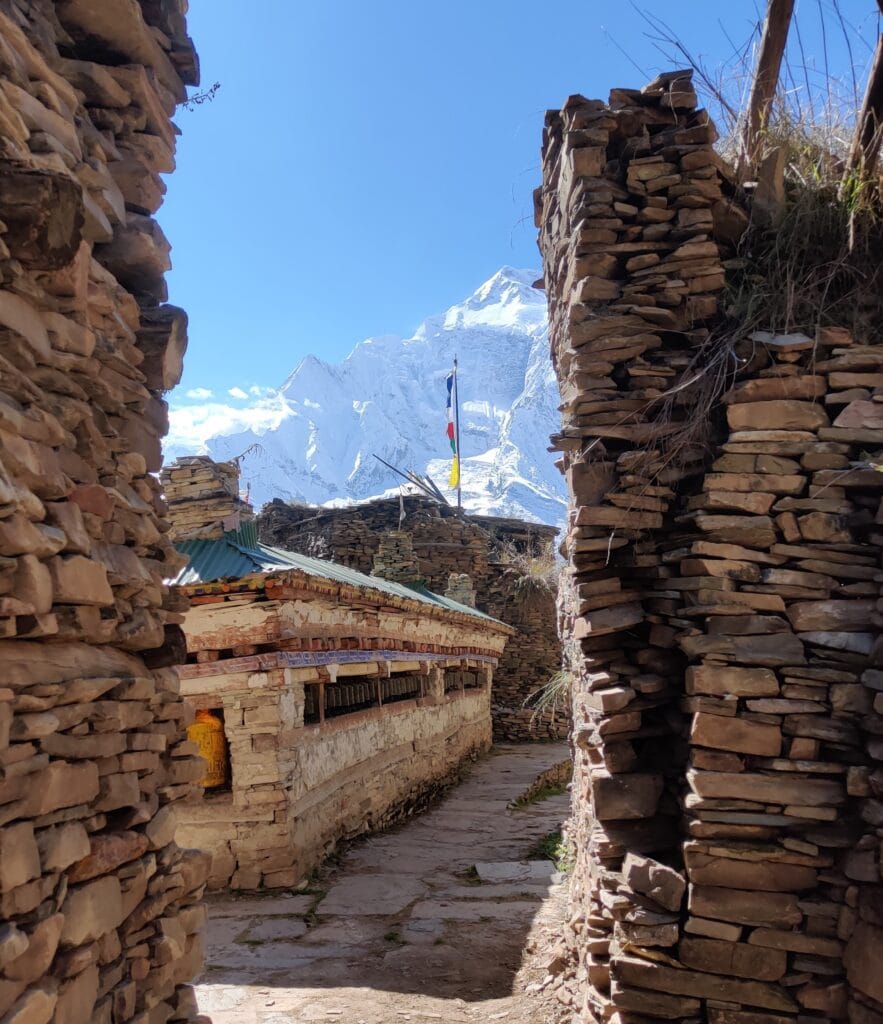
After lunch at Ngawal, we started the long easy descent observing the jagged rock formations in the valley. We hike past Brakha (ancient settlement) and the famous suspension bridge over the river looking towards Annapurna. Finally, arriving in Manang for a 2-night stay as Day 7 would be an altitude acclimatisation day. Manang is the largest town on the Cicruit and it is where most Jeeps finish before returning down the valley. There are plenty of shops selling souvenirs and supplies as the last place before crossing Thorong La. It’s a busy village full of trekkers, guides and porters with lots of teahouses to find food & a bed as well as several bakeries! I tried Nepalese Momos for the 1st time and were delicious veggie dumplings – I highly recommend them! A good night’s sleep with a slight lie-in after 4 days of trekking to rest the body was much needed.
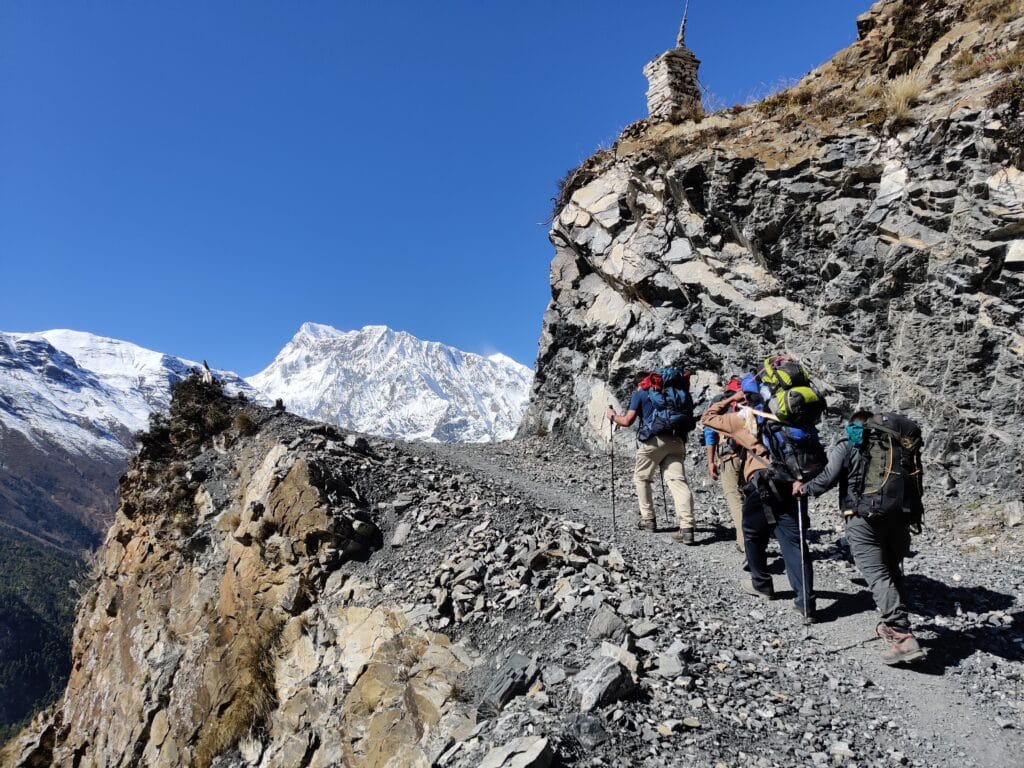
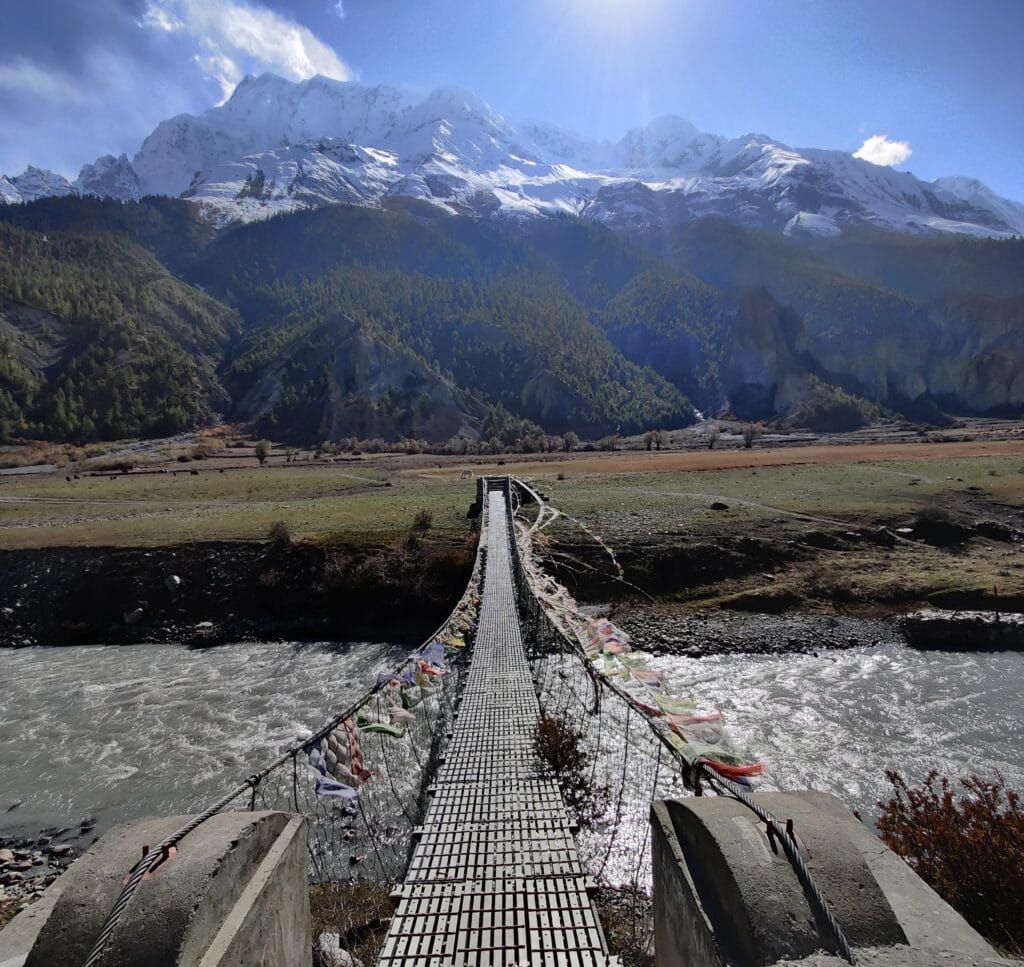
How Annapurna Circuit impacted me
Trekking
The physical and mental challenge of carrying your backpack for miles every day, each day for 10 days was very rewarding. I enjoyed the training to be as fit as possible but had to balance not hiking too fast to poorly acclimatise. I really enjoyed the daily stages which each had their own character and the simplicity of trekking to the next Teahouse. Life felt easy with no stress in the mountains, I could fully immerse myself in the trek and culture. The multiple days of hiking to create a larger trek made the completion more satisfying than most day hikes.
Natural Beauty
The images don’t do the reality justice with magnificent Himalayan mountains overhead, clear blue skies and a colourful Buddhist influence along the trail. The climates were changing every few days which tested the equipment and packing abilities. I learnt to respect the mountains as I felt insignificant to their presence and you have no control over their power. Trekking can be dangerous, especially at high altitudes where we heard stories of death at Tilicho Lake and injuries so I was grateful for no injuries or sickness. The impressive peaks do give you a new perspective on daily stress and what matters.
Religion
My research explained about the religions in Nepal and the Buddhist influence in Annapurna. I have not been religious before but was open-minded and curious about Buddhism. Over the trek, I paid my respects, prayed for safe passage and learnt about the Gompas, Stupas (called Chortens in Tibet) and Prayer flags. With Tibet being so close, the influence is very strong before crossing Thorong La where a Hindu influence in Muktinath is present. This is due to Muktinath being a holy site for religious pilgrims. Since my travels, I have resonated with some of the Buddhist teachings and practises which have given me a greater calm and perspective.
Mindfulness
Step after step, day after day. There is beauty in how simple trekking is and being surrounded by the mountains helps to relax and detox. Buddhism is known for its mindfulness practice and I could see the similarities to mindful walking. I found the internal monologue quickly dissipated after 2 days of trekking along the Annapurna Circuit. For hours on end, I would happily hike up mountains, along valleys and through villages being aware and present. I had limited phone and social media usage over the trip which helped me disconnect from the distractions online. I have remembered these lessons and found similarities on other mountain treks.
Social Confidence
The fellow backpackers are what I remember most fondly and the companionship of my guide Dawa. It was difficult to leave the UK on my own but I returned with a newfound confidence. As a solo traveller, it takes some bravery to spark up new conversations with strangers but like any skill, it becomes easier with practice. By the time I had crossed Thorong La, I had met with around 15 other trekkers and was more outgoing from my new connections.
Nepalese People & Culture
My Guide, Dawa, was incredible throughout my trip to ensure I had the best time and would be very hospitable. And like other Nepalese, his kind and warming nature was matched with a wicked sense of humour. The happiness of the guides, porters and locals was infectious! But despite the landscapes and people, there is a reminder that Nepal is one of the poorest countries in the world. There is poverty to be seen everywhere which is very humbling and shows how much we take for granted.
Food & Drink




Dal Bhat is the national dish of Nepal and is served literally everywhere! It is a lentil & curry dish usually with salad, popadums, and chutneys served on thalis. My favourite phrase from the Sherpas and Porters was “Dal Bhat Power” because it’s the only meal needed to power the naturally physically gifted locals up at high altitudes. The best part is after you’ve finished, you can get a 2nd serving and even a 3rd serving! This is a vegetarian dish and I only saw a meat variant in Kathmandu & Syange. I love Dal Bhat so much I have learnt to make it at home and inspired me to create the Dal Bhat Power Rankings of all teahouse versions I tried. The best Dal Bhat I had was in Tatopani thanks to the spicy curry, the deep flavour of lentil soup and the addition of a yoghurt.
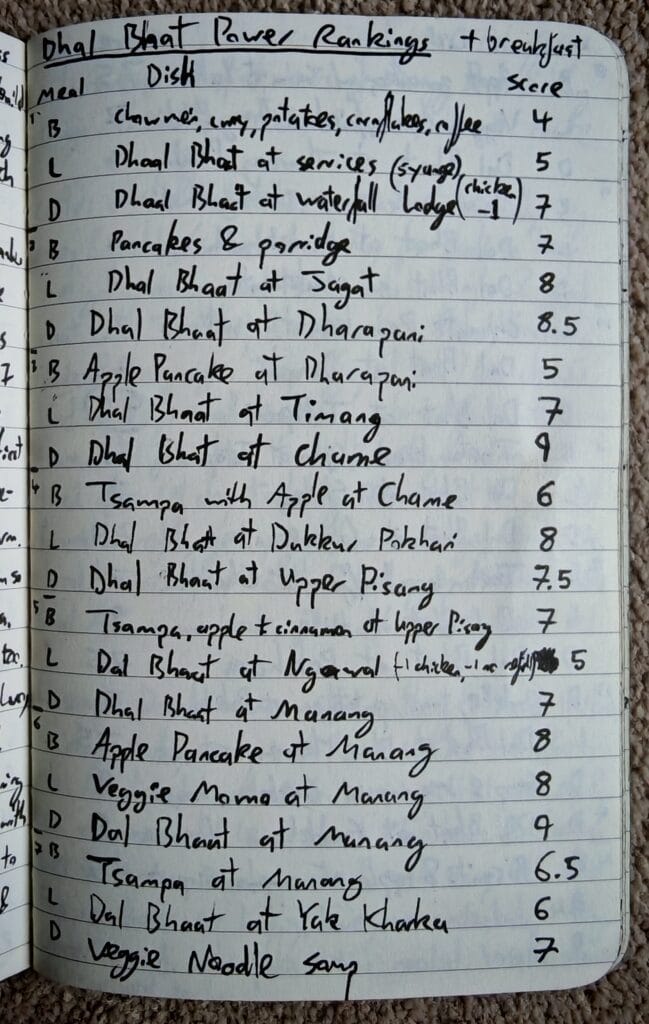
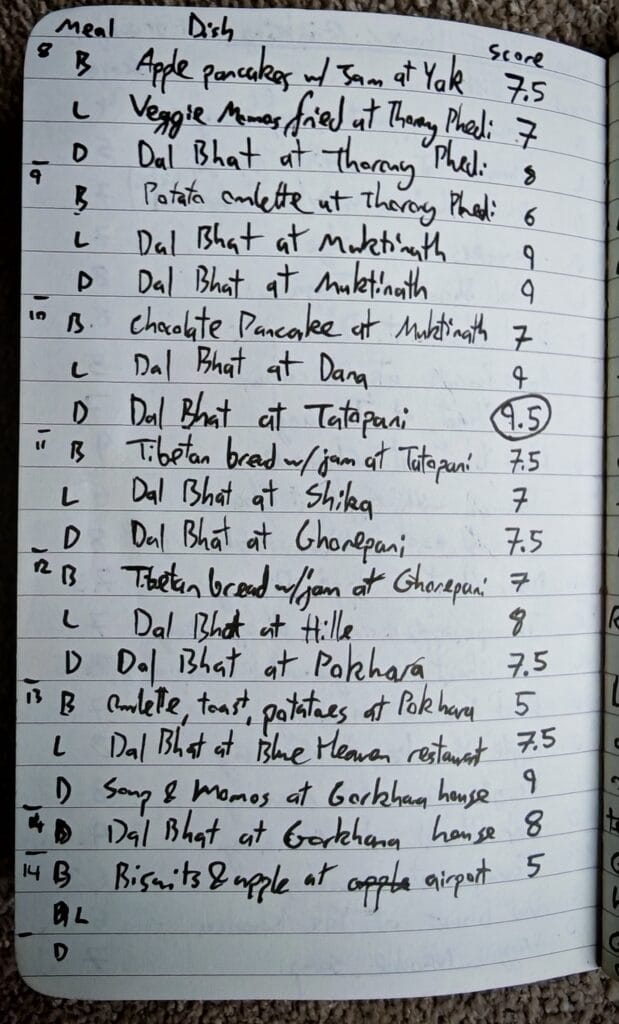
Accommodation
All of the accommodation in Nepal was indoors (No Camping) and varied in quality and facilities. As the tour package included Teahouses and Hotels, I cannot comment on the value of each accommodation. My Guide, Dawa, was a superstar in finding good teahouses along the route and Ram (owner of Sherpa Trekking) had pre-booked Hotels in Kathmandu and Pokhara. Below is a summary table of the teahouses and hotels I stayed at with Upper Pisang and Muktinath being my favourites!
| Location | Room | Facilities | Hall | Lounge | Score |
| Kathmandu | 9 | 10 | 6 | 6 | 8 |
| Syange | 9 | 8 | 7 | 8 | 8 |
| Dharapani | 7 | 7 | 7 | 7 | 7 |
| Chame | 6 | 4 | 7.5 | 9 | 6.5 |
| Upper Pisang | 8 | 8 | 7 | 10 | 9 |
| Manang | 5 | 3 | 8 | 8 | 6 |
| Yak Kharka | 8 | 5 | 7 | 10 | 7.5 |
| Thorong Phedi | 2 | 3 | 7 | 7 | 5 |
| Muktinath | 10 | 8 | 9 | 8 | 9 |
| Tatopani | 8 | 5 | 8.5 | 5 | 6.5 |
| Ghorepani | 7 | 6 | 7 | 8 | 7 |
| Pokhara | 10 | 10 | 4 | 6 | 8 |
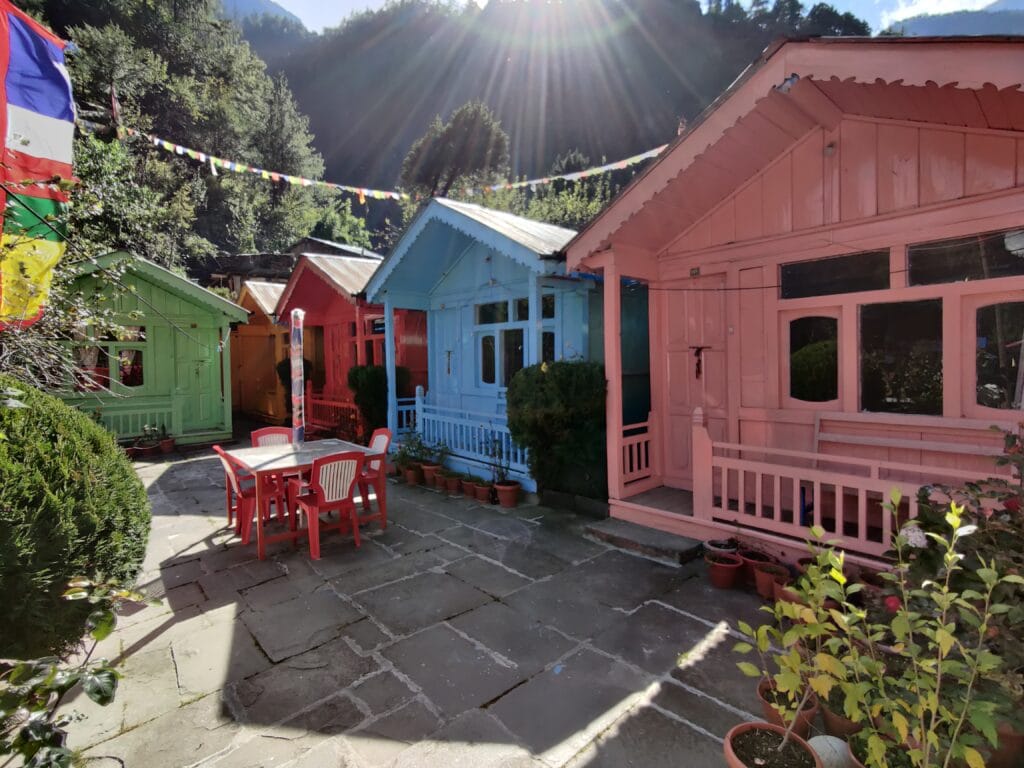
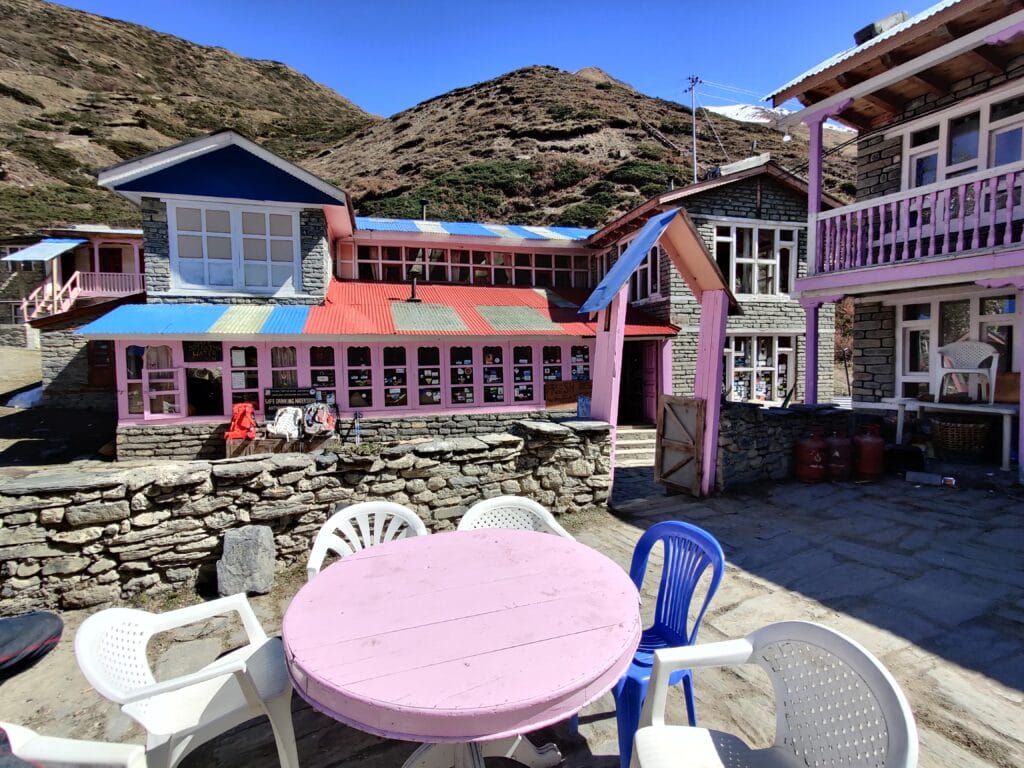
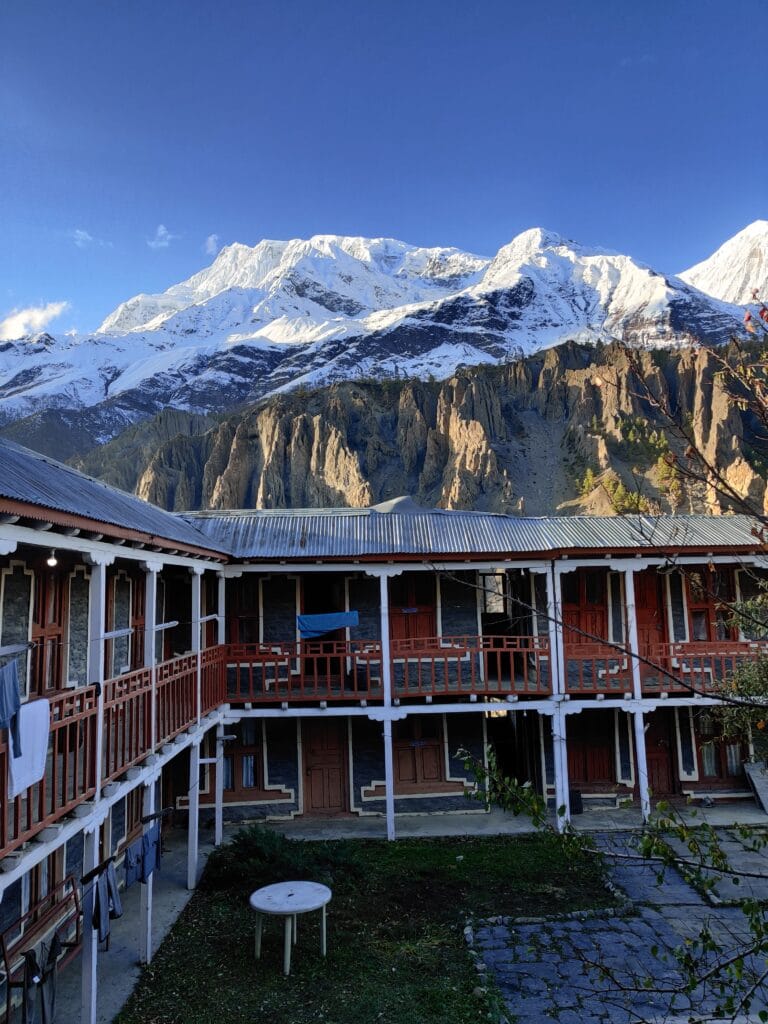
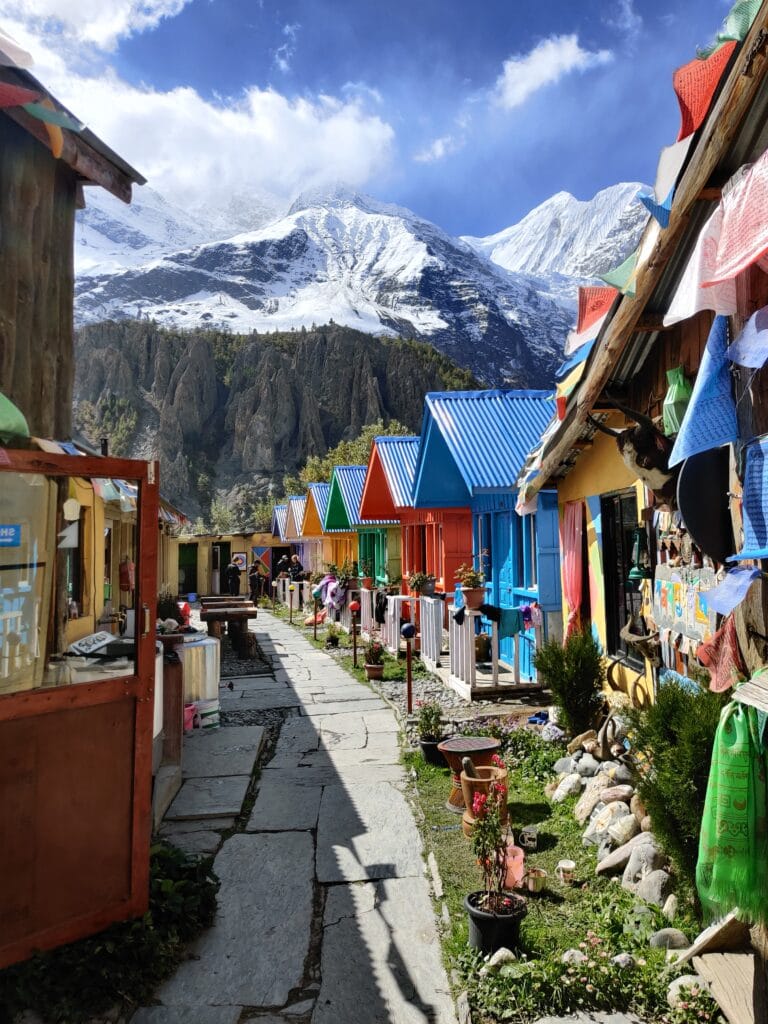
Final Thoughts
The Annapurna Circuit was a leap into the unknown in the world of trekking. I emerged more self-assured and outgoing than I had when I stepped onto the plane to Kathmandu. The first 7 days were the hardest as I developed a friendship with my Guide and got accustomed to the Nepalese way. But I wouldn’t have changed anything from those first 7 days up to Manang. Stay tuned as Part 2 – Manang to Muktinath and Part 3 – Muktinath to Kathmandu will be published soon.
Have you visited the Annapurna region or Nepal? Please let me know if you’ve done any other Himalayan Treks as I plan to return for more adventures! And please share this post with anyone who is interested in doing the Annapurna Circuit Trek.
Pingback: Thorong La: The Sensational and Famous Highest Trekking Pass - Backpacker's Mentality
Pingback: Poon Hill: The Best Himalayan Mountain Sunrise Hike - Backpacker's Mentality
Pingback: What Are the Best Tips for Backpacking for Beginners - Backpacker's Mentality